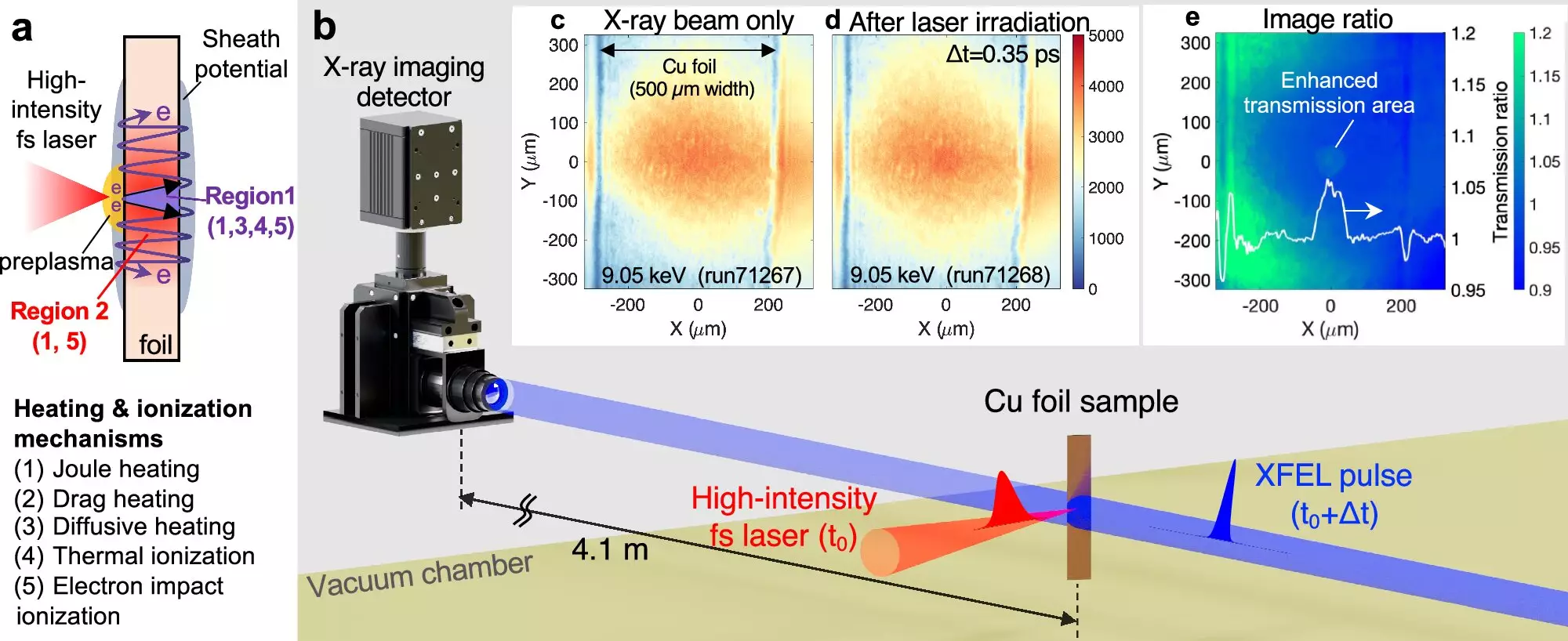In the realm of modern physics, few phenomena intrigue scientists more than the transition between states of matter, particularly when it comes to the manipulation of materials under extreme conditions. Recent research led by Hiroshi Sawada and his team at the University of Nevada, Reno has unveiled critical insights into a unique state of matter known as warm dense matter (WDM). This state occurs when materials like copper are subjected to extreme temperatures, upwards of 200,000 degrees Fahrenheit, almost instantaneously due to high-powered laser pulses. The significance of this breakthrough extends beyond mere academic exploration; it touches upon our understanding of various astrophysical and engineering processes.
The study of WDM is crucial for comprehending phenomena occurring in the interiors of giant planets and in the mechanics behind laser fusion energy, a potential game-changer for future energy solutions. By utilizing cutting-edge technology such as ultrafast X-ray pulses, researchers can effectively visualize how materials behave when thrust into such extreme thermal environments. This approach not only unveils the mechanisms at play during the phase transition but also provides data that can refine existing theoretical models.
The methodology applied by Sawada and his team revolves around a sophisticated technique known as a pump-probe experiment. During the experimentation, a high-powered laser serves as the “pump” that rapidly warms up a thin strip of copper, transforming it into a state of warm dense plasma. Following this rapid heating, an X-ray pulse (the “probe”) captures images of the temperature changes as the plasma evolves. The need for unprecedented precision in both timing and measurement cannot be overstated, as the timeframes involved are exceedingly short, often on the order of picoseconds.
The researchers employed the state-of-the-art X-ray Free Electron Laser (XFEL) at the SACLA facility in Japan, one of the few locations globally equipped to conduct such intricate experiments. This facility provides unique capabilities, enabling scientists to track thermal dynamics at a microscopic level, thus facilitating a more profound understanding of the processes involved in forming plasma from solid matter.
Historically, tracking the heat transfer and ionization processes in materials like copper during laser interaction posed substantial challenges. Prior to this research, the phenomenon was largely theoretical, grounded in models and simulations that often bore little resemblance to experimental outcomes. According to Sawada, initial predictions, while based on sound physics, significantly deviated from the actual observations made during experiments. This discrepancy highlights the nuanced complexity of material behavior under extreme conditions, which remains a frontier that physicists are eager to decode.
Moreover, the setup for this research is incredibly competitive due to limited availability of laser beam time, necessitating meticulous preparation to ensure that every shot captured relevant data. Each laser pulse essentially destroys a portion of the copper strip, rendering every shot crucial for obtaining results. The team managed to collect data over multiple shots, significantly advancing their understanding of thermal responses in condensed matter.
Beyond its immediate academic contributions, the implications of understanding warm dense matter stretch into several scientific realms. This research could enhance knowledge in fields as diverse as astrophysics, plasma physics, and high-energy-density science, potentially influencing the development of more efficient energy systems through inertial fusion. Additionally, the methods established here can be adapted for use at numerous other research facilities, enhancing the collaborative nature of global scientific inquiry.
As scientists continue to refine and adapt these experimental techniques, new questions will undoubtedly arise about the characteristics of materials when subjected to varying laser intensities or differing material configurations. The ability to observe quick thermal events on a micron scale will propel further explorations into how structural imperfections within materials affect their thermal transfer properties.
The groundbreaking research on warm dense matter conducted by Sawada and his international colleagues marks a significant advance in our understanding of material science under extreme conditions. By combining innovative laser technology with advanced imaging techniques, this study has opened new avenues for exploration that will not only enrich theoretical knowledge but also have practical applications in energy, materials science, and astrophysics. The research community eagerly anticipates future discoveries that will stem from this pioneering work, as it serves as a catalyst for ongoing exploration into the mysteries of matter at its most extreme.


Leave a Reply